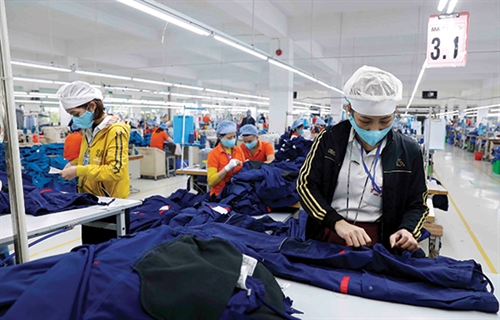According to the criteria for age-based film classification set by the Ministry of Culture, Sports and Tourism, C18 films must not contain full nude scenes, unless these scenes “conform to the content of the film and are neither too long nor overly repeated.” However, “how long is too long” remains unclear under current regulations.
Fierce controversies have recently broken out on social networks over Vi (Taste), an award-winning movie by young director Le Bao which is banned in Vietnam for being “unsuitable to Vietnamese culture.”
The movie is a joint project between a Vietnamese film studio, Le Bien Pictures, and a foreign partner. In March, Vi surpassed 11 other rivals to win the “Special Jury Award in Encounters” category, a competitive section created to support new voices in cinema at the 71st Berlin International Film Festival. Earlier in 2020, the film won the “Most Potential Project” award at the Singapore International Film Festival. In April, Le Bien Pictures was fined for bringing the film to international film festivals without a film dissemination license from state management agencies. Under current laws, films must be certified by the Ministry of Culture, Sports and Tourism’s Cinema Department or approved for broadcast before being sent to festivals. Later in July, the Cinema Department decided to ban the film from being screened in Vietnam. Director of the Cinema Department Vi Kien Thanh told VietNamNet e-newspaper that the main reason behind the ban is the 30-minute long scene in which four female characters and one male character appeared naked.
Interestingly, the controversies did not spark at the time the ban was issued but erupted after Dong Thi Phuong Thao, the producer of the movie, revealed that Vi had “renounced its Vietnamese nationality” and its copyright ownership had been transferred to a Singaporean business. In other words, Vi is no longer a Vietnamese film.
“Actually, I still haven’t calmed down. Up to now, it remains to be a heart-breaking thing for not only the producer, but the whole creative collective”, Thao said at a webinar held on September 26 among film industry insiders to contribute opinions on the draft revised Law on Cinematography, which is expected to be passed by the National Assembly next year.
Censorship vs artistic freedom
The case of Vi once again stirred debates over the relation between censorship and artistic freedom. The necessity of state censorship of cinematographic works is undeniable in any country. The issue here is how to design the censorship system in a way that enables it to filter out unsuitable, uncultured or harmful contents while guaranteeing filmmakers’ right to artistic freedom. This is a matter of concern of not only film industry insiders but also legal experts and the public, amidst the ongoing revision of the 2006 Law on Cinematography.
In an interview with Nhan Dan (People) Weekly Newspaper, director Nguyen Huu Tuan said: “I believe that it is necessary for the State to adopt regulations on movie contents as they have been done in many countries in the world. However, the regulations must be clear and specific. Creativity in cinema is unlimited, thus the provisions on it cannot be cursory and vague, which is the major shortcoming in the current Law on Cinematography.”
“Vague and unspecific regulations will force members of film censorship councils to interpret these regulations according to their personal understanding, which can lead to unfairness in film censorship,” Tuan added.
Back to the case of Vi, director Nguyen Hoang Diep, who was a member of the National Censorship and Classification Council for Feature Films at the time Vi was submitted to the council for appraisal, admitted that this was a big lesson for her as a movie censor. Diep, on the one hand, said she herself believed that the nude scene in Vi was necessary for the film but, on the other hand, affirmed that ban on the film was unavoidable.
According to the criteria for age-based film classification set by the Ministry of Culture, Sports and Tourism, C18 films must not contain full nude scenes, unless these scenes “conform to the content of the film and are neither too long nor overly repeated.” However, “how long is too long” remains unclear under current regulations.
“When appraising Vi, the council realized that it is impossible to categorize the film as C18. But there is no other label higher than C18. Hence the film is banned,” Diep said at the above-mentioned webinar.
“The interestingness and beauty of cinematography aren’t the shields that protect films from not being banned. When a film violates legal prohibitions, it will obviously be banned,” she added.
At a group discussion of National Assembly deputies on the draft revised Law on Cinematography, deputy Pham Nam Tien from Dak Nong province said although there were opinions that film censorship councils are overly interfering and forcing filmmakers to change contents of films in order to get film dissemination licenses, he believed the councils have fulfilled their responsibilities in a spirit of goodwill, aiming to bring to the public fine and “clean” cinematographic works.
 |
| Vietnam’s cinema industry is undergoing great changes__Photo: https://saostar.vn/ |
“However, a highly creative artistic work should be judged from different angles,” Tien shared his viewpoint. “Film censorship councils and film producers should sit down and find a common voice on this [censorship] issue”, he suggested.
Time for building a new film censorship and classification system
In order to ease the work of both film censors and makers, there should be a detailed set of specifically quantitative criteria for film censorship and classification.
According to director Tuan, “it is nothing better than building a system of specific age ratings for movies. This system will create a basis for film censorship councils to better their work and avoid assessment by feeling. It will also help filmmakers determine what to do to have their films classified in an age rating that suits their business strategy.”
Another matter of concern is the delegation of film censorship and classification responsibility. Under the latest draft of the revised Law on Cinematography, such responsibility would be assigned to localities rather than placed solely on the National Film Censorship and Classification Councils as at present.
According to Article 32 of the draft Law, in addition to film censorship and classification councils established by the Ministry of Culture, Sports and Tourism, there would be provincial-level councils set up by local administrations. Meanwhile, the censorship and classification of films for television broadcasting would be carried out by councils of press agencies.
Particularly for films broadcast on the web, organizations and individuals disseminating films on the cyberspace would themselves classify their films and display the classification results and content warnings for viewers. The Ministry of Culture, Sports and Tourism would join hands with the Ministry of Information and Communications in inspecting the classification of films broadcast on the cyberspace in accordance with law.
The new film censorship and classification system proposed in the draft Law is considered a new flexible approach of state management agencies to adapt to the rapid development of online film distribution and dissemination services, thus reducing the burden of costs and personnel for state management agencies while promoting international integration and cross-border e-commerce.
Commenting on the proposal, Nguyen Quang Dong, Director of the Institute for Policy Studies and Media Development of the Vietnam Digital Communications Association, said the pre-licensing inspection mechanism is usually applied for the purpose of limiting potential risks in case great threats are in existence. Meanwhile, the post-licensing inspection mechanism not only meets state management requirements but also conforms to the actual situation of the film industry, especially video on demand services.









